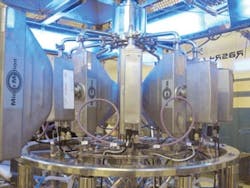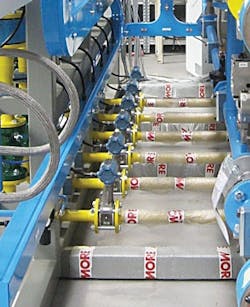Check Out Montague's Google+ profile.
It shouldn't be surprising, but adding innovations and new capabilities to familiar technologies can make them show up in some unexpected places. For instance, most of the basic parameters of flow sensing and control are well known, but continual advances in flow conditioning and management are enabling them to be implemented in some unusual applications and settings, and be applied by users that hadn't considering using them before or couldn't afford them.For example, while it might be surprising to see a bunch of Coriolis flowmeters sprouting on top of a filling machine, that's exactly what GF S.p.A. in Parma, Italy, did recently to reduce filling times, improve accuracy and repeatability, and enable tighter filling tolerances on its advanced filling equipment (Figure 1). GF's filling machines are used in pharmaceutical, food and medical applications to precisely measure compounds for injections, infusions, ophthalmic preparations, syrups and detergent solutions.
Read Also: The Holy Grail in Coriolis Flowmeters
"We were able to improve system response time and reduce batch cycle times by taking advantage of integrated valve control from the transmitter, rather than the traditional pulse output set up through a PLC," explains Serventi. "The reliability and accurate results provided by the Micro Motion instruments have now been validated by GF customers over a number of successful applications."
Nuclear and Underwater
Likewise, NRG Laboratory's facility in the Netherlands makes nuclear medical isotopes and tests materials for nuclear power plants. It uses flow metering to measure its nuclear laboratory and reactor's basin cooling system, which uses a medium called "demiwater."
When its old vortex flowmeter wore out and a replacement wasn't available, NRG Lab began searching for a substitute with long-life electronics, low maintenance costs, small footprint, good underwater performance and the ability to withstand radiation. Eventually, NRG Lab settled on McCrometer's differential pressure V-Cone flowmeter with built-in flow conditioning for accuracy to +0.5% of the flow rate with +0.1 repeatability. It suits tight retrofit installations because it only requires a minimal 0-3 pipe diameters upstream and 0-1 diameters downstream.
NRG Lab reports its V-Cone flowmeter performs better than its former vortex flowmeter, requires no maintenance such as changing cables, and enhances safety by avoiding having any electronics near the reactor vessel.
Aiding Lubrication Applications
To help give its new lubricant bottom-loading bay more efficient and safer driver-initiated loading, Shell Lubricant Center at Stanlow refinery in Ellesmere Port, Cheshire, U.K., recently deployed 10 Promass 83F Coriolis mass flowmeters from Endress+Hauser. The flowmeters use Profibus DP communications, and this provides added density and temperature data, reduces cabling and I/O requirements, and links seamlessly with Shell's inventory control system. Because Shell's tankers load according to volume, knowing product density is crucial due to changes cause by temperature fluctuations.
Read Also: Trends Among the Top 10 Flowmeter Technologies
Also, the driver-initiated loading functions are more efficient because drivers no longer have to wait for manual link-ups to pumps; load qualities and grades are validated automatically; and this streamlines and cuts the required steps by 50%. "Driver-initiated loading has proven to be a real benefit all round," says Chris Turner, Shell Lubricant's E&I engineer. "All the data provided by Profibus, such as diagnostic information, helps us maintain smooth operation and system integrity, and the Promass flowmeters are low-maintenance, accurate, secure and user-friendly."
Likewise, Novelis' aluminum flat-rolling mill in Lüdenscheid, Germany, needs to constantly lubricate the 13,000 tons of aluminum rolls it makes each year with high-quality oil. However, this oil often thins during production, which can reduce lubrication, damage the rolls, and stop production. Oil thinning is accompanied by a minimum density change of around 0.8 grams per liter (g/l).
To prevent these problems, Novelis recently installed CoriolisMaster FCB300 mass flowmeters from ABB, which can perform density measurements at up to 0.5 g/l in field adjustments. This means fluctuations in density can be detected much earlier, and Novelis can take countermeasures to prevent damage to the rolls. Besides high-precision density measurement, FCB350 also gives the rolling mill a smooth density signal, so unique trends can be observed.
Optimized Oxygen = Stronger Steel
More had been using differential pressure flowmeters to measure critical oxygen flows in its furnaces, but they made it difficult to handle changing process requirements and meet user demands for more accurate control. The company needed more accurate instruments with a broader measurement range, so it evaluated vortex flowmeters, and implemented Emerson's Rosemount 8800 vortex flowmeters, which are designed to addresses the limits of traditional vortex flowmeters. For example, its Adaptive Digital Signal Processing (ADSP) signal filtering and a mass-balanced sensor design maximize measurement reliability, and eliminate the impact of vibrations on measurement accuracy. Also, to meet demands for greater flexibility in furnace installations, Rosemount 8800's 25:1 rangeability helps optimize gas heaters, providing greater opportunities to vary steel characteristics for different applications.
"By implementing Emerson's vortex technology, we've been able to build electric arc furnace solutions that guarantee optimum furnace efficiency for users," says Roberto Urbani, More's purchasing manager. "We've been able to optimize furnace efficiency in terms of productivity and steel quality. Over-oxidation is no longer an immediate concern, which extends furnace lifecycles. Energy consumption and ambient pollution were also reduced."








